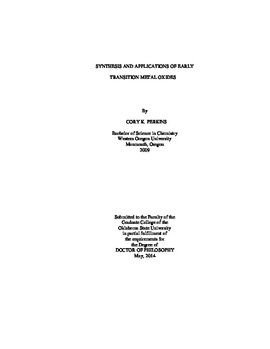| dc.contributor.advisor | Apblett, Allen | |
| dc.contributor.author | Perkins, Cory K. | |
| dc.date.accessioned | 2015-06-17T20:07:27Z | |
| dc.date.available | 2015-06-17T20:07:27Z | |
| dc.date.issued | 2014-05 | |
| dc.identifier.uri | https://hdl.handle.net/11244/15062 | |
| dc.description.abstract | An optimized synthesis of sodium molybdenum bronze was presented using 1/3 of the expensive Na2MoO4*2H2O buffer as the conventional method. The need for a N2 atmosphere was also eliminated. Further, the reaction time was increased from 3 hours to 24 hours, yielding a product with composition of Na0.29H0.04MoO3*0.45H2O. Using low-cost Na2HPO4*7H2O as a buffer produced a pure sodium bronze, with a composition of Na0.30MoO3*0.52 H2O and improving the yield from 66% to 73%. | |
| dc.description.abstract | Metal tungstates and molybdates were produced by a variety of methods, all producing nanocrystalline materials with very high yields. A nanometric suspension of MoO3 proved to be highly reactive towards Cs+, Ag+, and Pb2+ allowing direct conversion to molybdates and polymolybdate materials. Scheelite-type alkaline earth metal tungstates were produced via a reaction of the metal acetates with tungsten oxide and tungstic acid, with acetic acid as the only byproduct. However, using Mg(CH3COO)2 produced a novel magnesium polytungstate. A single-source precursor method based on alpha-hydroxycarboxylate complexes was also reported for the synthesis in a wide variety of useful metal molybdates and tungstates, all in very high yields. | |
| dc.description.abstract | Numerous environmentally friendly materials were developed as sorbents for heavy metals, precious materials, and radionuclides. Al2W3O12 proved to be an ideal candidate for the recovery of gallium from water and industrial waste streams. MoO3 proved to be highly reactive towards aqueous lead, however toxicity of the sorbent becomes an issue due to the solubility of the sorbent. Using non-toxic and insoluble WO3 as a sorbent was more appropriate for potable water remediation applications. The surface areas of the WO3 sorbents correlated to both their reactivity and capacity for the uptake of heavy metals. Mesoporous-WO3 proved to be the most reactive material towards lead. CaWO4 showed a very high reactivity for the divalent heavy metals: Pb2+, Cu2+, and Cd2+, with the highest reactivity towards lead and lowest towards cadmium. CaWO4 was shown to be an excelled sorbent for the radionuclide surrogates Sr2+ and UO22+. H2WO4 on high-surface area pellets proved to be an excellent sorbent for UO22+. Finally, all of the materials were able to be recycled with only NaCl or NH4Cl as byproducts, allowing for both the sorbents and the analytes to be recovered in very high yields. | |
| dc.format | application/pdf | |
| dc.language | en_US | |
| dc.rights | Copyright is held by the author who has granted the Oklahoma State University Library the non-exclusive right to share this material in its institutional repository. Contact Digital Library Services at lib-dls@okstate.edu or 405-744-9161 for the permission policy on the use, reproduction or distribution of this material. | |
| dc.title | Synthesis and applications of early transition metal oxides | |
| dc.contributor.committeeMember | Materer, Nicholas | |
| dc.contributor.committeeMember | Blum, Frank | |
| dc.contributor.committeeMember | Weinert, Charles | |
| dc.contributor.committeeMember | Foutch, Gary | |
| osu.filename | Perkins_okstate_0664D_13418.pdf | |
| osu.accesstype | Open Access | |
| dc.type.genre | Dissertation | |
| dc.type.material | Text | |
| dc.subject.keywords | calcium tungstate | |
| dc.subject.keywords | heavy metals | |
| dc.subject.keywords | molybdenum trioxide | |
| dc.subject.keywords | radionuclides | |
| dc.subject.keywords | sorption | |
| dc.subject.keywords | tungsten trioxide | |
| thesis.degree.discipline | Chemistry | |
| thesis.degree.grantor | Oklahoma State University | |
